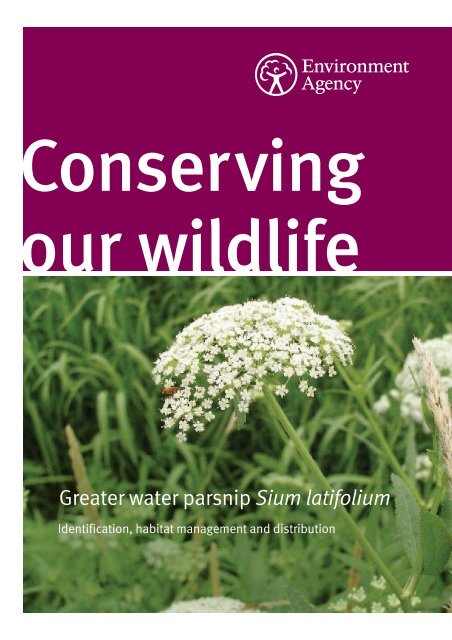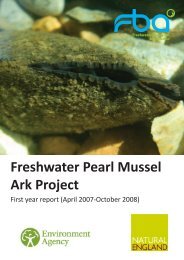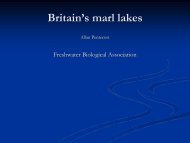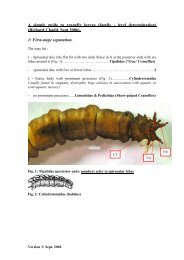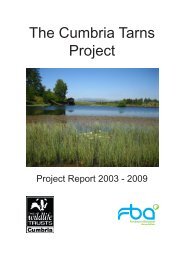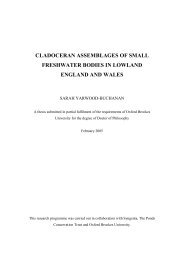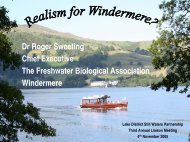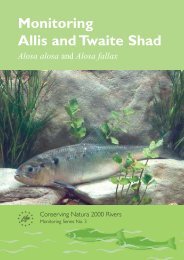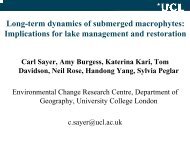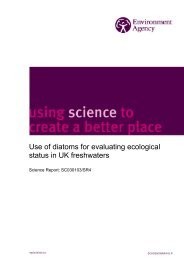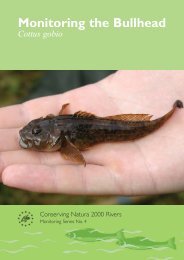Greater water parsnip Sium latifolium - FreshwaterLife
Greater water parsnip Sium latifolium - FreshwaterLife
Greater water parsnip Sium latifolium - FreshwaterLife
Create successful ePaper yourself
Turn your PDF publications into a flip-book with our unique Google optimized e-Paper software.
Conserving<br />
our wildlife<br />
<strong>Greater</strong> <strong>water</strong> <strong>parsnip</strong> <strong>Sium</strong> <strong>latifolium</strong><br />
Identification, habitat management and distribution
We are the Environment Agency. It’s our job to look after<br />
your environment and make it a better place – for you,<br />
and for future generations.<br />
Your environment is the air you breathe, the <strong>water</strong> you<br />
drink and the ground you walk on. Working with business,<br />
Government and society as a whole, we are making your<br />
environment cleaner and healthier.<br />
The Environment Agency. Out there, making your<br />
environment a better place.<br />
Published by:<br />
Environment Agency<br />
Rio House<br />
Waterside Drive, Aztec West<br />
Almondsbury, Bristol BS32 4UD<br />
Tel: 0870 8506506<br />
Email: enquiries@environment-agency.gov.uk<br />
www.environment-agency.gov.uk<br />
© Environment Agency<br />
All rights reserved. This document may be reproduced<br />
with prior permission of the Environment Agency.<br />
March 2006
The greater <strong>water</strong> <strong>parsnip</strong> is a<br />
wetland flower, found in wet ditches,<br />
tall herb fens and marshes. It has<br />
declined rapidly in the last 40 years.<br />
We want to halt<br />
its decline before<br />
it is too late.<br />
The greater <strong>water</strong> <strong>parsnip</strong> is one of<br />
nearly 400 species identified in the<br />
UK Biodiversity Action Plan as needing<br />
our protection. We work to protect these<br />
species for the generations that come after us:<br />
your help could make all the difference.<br />
This leaflet shows you how to recognise the greater <strong>water</strong><br />
<strong>parsnip</strong>, and describes the conditions in which it will<br />
thrive. Simple changes, such as limited grazing and gentler<br />
ditch clearance, may be all that is needed to allow this<br />
plant to flourish.<br />
Acting now and adapting your management practices,<br />
if necessary, will make a difference. If you find the greater<br />
<strong>water</strong> <strong>parsnip</strong> on your land, or in the area you work,<br />
please get in touch. Your feedback will allow us to target<br />
surveys and improve our knowledge of the current places<br />
where the greater <strong>water</strong> <strong>parsnip</strong> can be found.<br />
You can record possible sightings on our website<br />
at www.environment-agency.gov.uk/conservation.<br />
Please give a national grid reference if you can.<br />
seed head<br />
Environment Agency Conserving our wildlife – <strong>Greater</strong> <strong>water</strong> <strong>parsnip</strong> <strong>Sium</strong> <strong>latifolium</strong> 3
Identification<br />
Key points:<br />
• tall (up to 2m);<br />
• hairless, perennial plant<br />
with strongly ridged stems;<br />
• flowers: white, large umbels<br />
(50–100mm in diameter) from<br />
July to September;<br />
• aerial leaves are pinnate with<br />
about five pairs of toothed leaflets;<br />
• feather-like submerged leaves<br />
that are not always present;<br />
Howes<br />
G by<br />
• fruits: oval, with prominent ridges;<br />
sets seed in September or October;<br />
• poisonous if eaten. Illustrations<br />
Habitat<br />
The greater <strong>water</strong> <strong>parsnip</strong> is found<br />
in wet ditches and tall herb fens and<br />
marshes. The plant grows in shallow,<br />
still or slow-moving <strong>water</strong> and is generally<br />
found on peat or alluvial soils.<br />
Once established, the greater <strong>water</strong><br />
<strong>parsnip</strong> can grow among other tall<br />
wetland plants such as common reed<br />
(Phragmites australis) or reed-mace<br />
(Typha spp). However, the habitat<br />
must be more open for its seeds to<br />
germinate and young plants to grow.<br />
4 Environment Agency Conserving our wildlife – <strong>Greater</strong> <strong>water</strong> <strong>parsnip</strong> <strong>Sium</strong> <strong>latifolium</strong><br />
The greater <strong>water</strong> <strong>parsnip</strong> will not<br />
survive in heavy shade – for example<br />
in alder or willow carr wet woodlands.<br />
However, it can grow at the edge of<br />
reed beds and osier beds, provided<br />
it is protected from over-grazing.<br />
Long periods of heavy grazing,<br />
frequent cutting or extensive ditch<br />
clearance will all damage the greater<br />
<strong>water</strong> <strong>parsnip</strong>’s chances of survival.
Status<br />
In the UK, the greater <strong>water</strong> <strong>parsnip</strong><br />
is classified as endangered having<br />
declined rapidly over the last 40<br />
years. The plant receives general<br />
protection under the Wildlife and<br />
Countryside Act 1981 (as amended).<br />
The greater <strong>water</strong> <strong>parsnip</strong> is listed as<br />
a UK Biodiversity Action Plan (BAP)<br />
species, and has national and local<br />
Biodiversity Action Plans. For more<br />
information, see the BAP website:<br />
www.ukbap.org.uk ditch habitat<br />
Distribution<br />
The greater <strong>water</strong> <strong>parsnip</strong> is<br />
found on lowland floodplains.<br />
It has strongholds in:<br />
• Eastern England, eg the Ouse<br />
Washes in Cambridgeshire<br />
and Norfolk;<br />
• Southern England,<br />
eg Romney Marsh in Kent;<br />
• Loch Erne in<br />
Northern Ireland.<br />
Habitat restoration and<br />
appropriate management<br />
are required in these and<br />
other historic locations.<br />
This will maintain and<br />
increase its distribution,<br />
ensuring the long-term survival<br />
of the species.<br />
Distribution of greater <strong>water</strong> <strong>parsnip</strong><br />
Number of<br />
10km 2 occurrences<br />
1987–1999<br />
1970–1986<br />
Pre-1970<br />
Environment Agency Conserving our wildlife – <strong>Greater</strong> <strong>water</strong> <strong>parsnip</strong> <strong>Sium</strong> <strong>latifolium</strong> 5<br />
Map source: New Atlas of the British and Irish Flora
Management<br />
Sympathetic management is required to assist the plant’s<br />
continued survival. These management guidelines are<br />
based on the best knowledge currently available.<br />
• Clean ditches sensitively – rotate clearances; leave<br />
alternate lengths untouched; if you can, leave plant roots<br />
in place.<br />
• Cut back vegetation infrequently and leave some patches<br />
uncut. Cut after October when seed is set.<br />
• Prevent excessive shading from shrubs and trees.<br />
• Allow minimal cattle grazing – where grazing is<br />
beneficial for other species consider excluding cattle<br />
until after the greater <strong>water</strong> <strong>parsnip</strong> has set seed,<br />
and/or allow grazing only in certain years. Limited<br />
grazing helps the plant, by creating poached and<br />
more open areas in which seeds can germinate.<br />
• Maintain <strong>water</strong> levels at or near ground level all<br />
year round. The greater <strong>water</strong> <strong>parsnip</strong> is at risk<br />
from drying out in summer, and from the freezing<br />
of its roots in winter. The plant can tolerate high<br />
winter flooding and benefits from being submerged<br />
(50–100mm) in winter.<br />
• Create suitable habitats alongside existing populations<br />
– this will encourage the greater <strong>water</strong> <strong>parsnip</strong> to spread<br />
and increase in number. Grazing and trampling by cattle<br />
for one or two years will open up an adjacent patch of<br />
vegetation. Then, when young plants are established,<br />
exclude the livestock with ditches or fencing to create<br />
islands of taller vegetation.<br />
• Re-introduction may be an option, where natural<br />
regeneration from the seed bank is not possible. Only use<br />
seed collected from the same catchment following the<br />
guidelines from the Joint Nature Conservation Committee<br />
(JNCC). The <strong>Sium</strong> steering group can provide more<br />
information on seed propagation and re-introductions.<br />
6 Environment Agency Conserving our wildlife – <strong>Greater</strong> <strong>water</strong> <strong>parsnip</strong> <strong>Sium</strong> <strong>latifolium</strong><br />
fen habitat
References:<br />
The Vascular Plant Red Data List for Great Britain,<br />
C M Cheffings and L Farrell (eds), JNCC, 2005<br />
A Policy for Conservation Translocations of Species<br />
in Britain, JNCC, 2003<br />
New Atlas of the British and Irish Flora, C D Preston,<br />
D A Pearman and T D Dines, Oxford University Press, 2002<br />
Acknowledgments:<br />
The <strong>Sium</strong> steering group brings together experts from<br />
the various organisations working to protect the greater<br />
<strong>water</strong> <strong>parsnip</strong>. The group would like to thank all those who<br />
helped to produce this leaflet. This leaflet has been jointly<br />
funded by the Environment Agency and English Nature.<br />
Further information<br />
The Environment Agency co-ordinates the national BAP<br />
for greater <strong>water</strong> <strong>parsnip</strong> and English Nature are the<br />
national BAP contact point.<br />
English Nature advises the government on wildlife issues.<br />
It is funded by Defra, the Department for Environment,<br />
Food and Rural Affairs. English Nature works to champion<br />
wildlife and to protect and enhance those species which<br />
currently face the threat of extinction.<br />
You can contact English Nature at:<br />
Northminster House<br />
Peterborough, PE1 1UA<br />
Telephone: 01733 455000<br />
Website: www.english-nature.org.uk<br />
In 2006 English Nature will become part of a new<br />
integrated government agency – Natural England.<br />
The new agency will also have parts of the Countryside<br />
Agency and the Rural Development Agency.<br />
Environment Agency Conserving our wildlife – <strong>Greater</strong> <strong>water</strong> <strong>parsnip</strong> <strong>Sium</strong> <strong>latifolium</strong> 7
Would you like to find out more about us,<br />
or about your environment?<br />
Then call us on<br />
08708 506 506 (Mon–Fri 8–6)<br />
email<br />
enquiries@environment-agency.gov.uk<br />
or visit our website<br />
www.environment-agency.gov.uk<br />
incident hotline 0800 80 70 60 (24hrs)<br />
floodline 0845 988 1188<br />
Environment first: This publication is printed on paper made<br />
from 100 per cent previously used waste. By-products from<br />
making the pulp and paper are used for composting and fertiliser,<br />
for making cement and for generating energy.<br />
GEHO0306BKJJ-E-E


